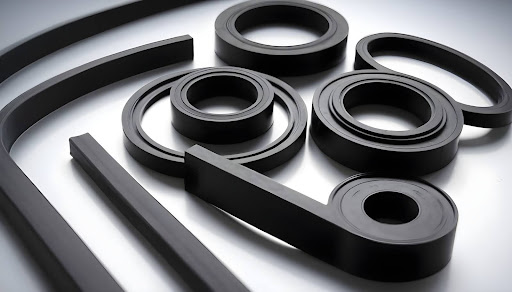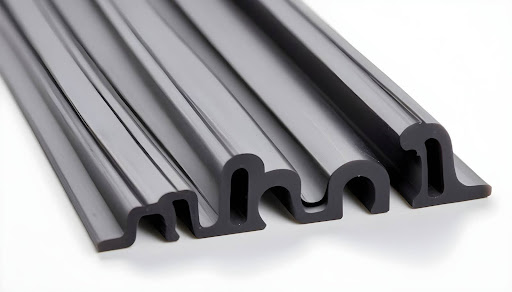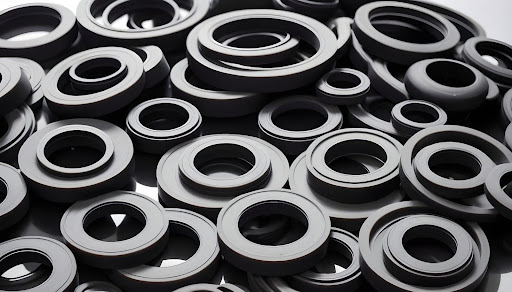Introduction
Seals have rubber as base material, in any place of an automobile they function and their use is unlimited in that duration of time in systems and applications. In this article focused on the deeper understanding of rubber seals, types, applications, benefits, manufacturing process, challenges, and FAQs will be discussed, and you will have a better picture of how important they are to the automotive performance and durability.
Table of Contents
Importance of Rubber Seals in Automotive Engineering

The role of rubber seals in automotive engineering is as important as other elements. These seals, playing the role of barriers, avoid leaks, contamination and also assure that each part of the vehicle that is essential is not compromised. From the engine or transmission, up to the braking system or the fluid delivery systems (all these, involves using various kinds of rubber seals), is the rubber seals that ensures efficient procedures and increases the lifespan of critical components. Saving opportunities is one of the leading contributions to performance optimization, safety deployment and overall car reliability along with reducing TCO.
Types of Rubber Seals

L Seals
L seals not only are the most frequently used but also are of the rubber seals family in the automotive sector. This design incorporates a lip or edge which helps in providing a strong seal that aids in maintaining airtight conditions and avoiding debris. The seals made from Lantan sealed various parts of the engine compartments, doors and windows. It was used where effective sealing was essential. They are well known for this molding and shaping, the cutting and the complex processes that determine that they could withstand wide temperatures ranges and pressures.
Ready to Improve Sealing Efficiency?
J Seals
By J as opposed to U-shaped seals, unique for hydraulic and pneumatic automotive systems, seal-off of hydraulic and pneumatic seals in cars is ensured. They demonstrate the ability to function at very high pressures creating site-to-anywhere sealing environments that ensure long-life operation without leakage. High performance J seals are robust in construction to withstand extreme pressure conditions without hampering performance and durability, even when working in harsh conditions.
Optimize Your Hydraulic Systems with Excel Rubber's J Seals
D Seals

PVC seals, commonly referred to as bulb seals, serve to seal off and weatherproof automotive components including car doors, trunks, and windows. Forming of such bulb-shaped nature certified its airtight function that denies water, dust, and noise from penetrating, which means comfort and high grade driving experience. Valtisols are the mainstay of elevated cabin construction as they are significant in reducing noise levels, improving the overall appearance, and ensuring pressure integrity of vehicles.
Explore Excel Rubber's D Seals for Effective Seal Resistance.
E Seals
E seals are the customized rubber seals which are intended for sealing that can be utilized mainly in automotive applications like gates, door, clutch housing, pressure adjusters and air pumps. These seals give finalized thoroughly customized options such as electrical cable connections, fluids to be passed and delicate components. O seals are one of the most critical parts of OR because they guarantee efficiency and stability of the units and, thus, meet requirements set by engineers for necessary specifications.
Applications of Rubber Seals
Rubber seals have a wide range of applications in the automotive industry, spanning across various systems and components:Rubber seals have a wide range of applications in the automotive industry, spanning across various systems and components:
– Engine Seals: Sealing the engine components to keep it oil-tight and preventing oil-contamination.
– Transmission Seals: Consequent actions such as minimizing leakage, energy economy, and optimal performance of transmission networks.
– Braking System Seals: Their Main task under this job profile is to make sure the brakes remain intact and that their hydraulic system is completely functional.
– Fluid Delivery Seals: Sealing fuel tank and delivery lines, coolant system and hydraulic lines.
– Door and Window Seals: Freight transport and toting lots of people in the leisure industry across long distances on just a single tank of fuel are now absolutely possible.
– Electrical Seals: Making sure linemen who have to work in bad weather or in dusty or corrosive environments are well protected.
– HVAC System Seals: For these systems during heating and cooling seasons, providing for optimum operation and air tightness.
– Exterior Seals: Improving aerodynamics; providing internal air spaces (for less wind noise); and offering attractive automotive design.
The variety and effectiveness of rubber seals manifest that they are in a position of the forefront in different automotive applications by the reason they attain superior performance, durability, safety, and hence, general satisfaction of clients.
Benefits of Using Rubber Seals
Among the many benefits of the rubber seal, the below are the most important.
The utilization of rubber seals offers a myriad of benefits to automotive manufacturers, mechanics, and vehicle owners:The utilization of rubber seals offers a myriad of benefits to automotive manufacturers, mechanics, and vehicle owners:
- Leak Prevention: With proper sealing using rubber seals, faultless seals are created that avoid fluid leaks, helping to prevent components from getting damaged and external contamination.
- Environmental Protection: Seals act as preventers of the fluid leaks and emissions, defined by environmentalists as being a core component of conservation and sustainable development endeavors.
- Enhanced Performance: The life span of the rubber seals is made longer through their ability to help in keeping the operating conditions favorable for all the automotive components which therefore leads to improved performance, efficiency and reliability.
- Durability: In addition to these, the rubber seals are designed to withstand extremely high temperatures, pressures and harsh environmental conditions meaning that their usefulness is extended and made robust.
- Noise Reduction: Properly functioning seals act as a game changer by bringing in a decrease in noise pollution that in turn contributes to more comfortable driving and lowered cabin sound levels.
- Cost-Effectiveness: Because of no leaks and components of automotive systems, the maintenance costs can be reduced, and the performance can be good and furthermore extend the lifespan of automotive systems.
All these bonuses together imply how a rubber seal can serve many purposes, not only improving the reliability and performance but also adding an appreciable customer satisfaction value.
Factors Influencing Seal Performance
Several factors influence the performance and effectiveness of rubber seals in automotive applications, including:Several factors influence the performance and effectiveness of rubber seals in automotive applications, including:
- Material Quality: The end product (seal) integrity and properties of rubber mixes influence their performance and life expectancy.
- Design Considerations: An effective seal would base its dimensional, profile and configuration design on the particular shape of the gasket to ensure the seal’s perfect functioning.
- Installation Techniques: Correct installation procedures and good installation skills are key in making the seals to operate properly and bring in the efficiency.
- Operating Conditions: Examples include thermal and mechanical effects, as well as subjections to manifestations of fluids, which all have great influence on seals functions and lifespan.
- Maintenance Practices: Frequent checking as well as repairing and replacing of seals are imperative for continued electricity production as systems cannot be faulty.
- Compatibility: Ensuring compatibility between seals and mating surfaces is critical to prevent leaks and optimize sealing effectiveness.
Understanding and addressing these factors are essential for maximizing seal performance, longevity, and reliability in automotive applications.
Manufacturing process of Rubber Seals

The manufacturing process of rubber seals involves several key steps, including:
- Material Selection: Optimally picking the rubber material on the basis of given requirements by working on temperature resistance, the chemical compatibility and lastly durability.
- Extrusion or Molding: The rubber material chosen will then be molded or extruded in the appropriate ways to the necessary sealing profile through extrusion or molding methods.
- Vulcanization: Rubber is either molded or machine extruded (for better buckling and heating), after which vulcanization is carried out (this process greatly improves the physical properties of the rubber like elasticity, strength, and resistance to heat and chemicals)
- Cutting and Finishing: The rubber now in the vulcanized state is cut to the exact finish specifications and goes on for finishing to make sure the edges are smooth, and it fits well.
- Quality Testing: A post-process, the Rubber Seals are tested for precision in measures, seamless integrity, and performance under a replicated operating environment.
- Packaging and Distribution: After unit quality control procedure is done, sealed RUBS units are packaged and delivered to the manufacturers, repair shops and aftermarket sellers, where they can be installed.
The manufacturing process of rubber seals is based on the technique of precision engineering rule, quality control rule and compliance to the requirement of the industry and standard to feed worthy and functional sealing solutions for automotive applications.
Challenges in Seal Design and Implementation
Despite their numerous benefits, designing and implementing effective rubber seals in automotive applications pose several challenges, including:
- Material Compatibility: The ability of rubber overlapping surfaces to prevent chemical reaction or material deterioration while still meeting with compatibility is the key to not letting sealing fail.
- Seal Integrity: Digitizing seals with secondary devices or humanize interfaces would suffice to empower citizens who are hearing or visually impaired.
- Energy efficient and faultless sealing stability must be kept in mind in case of considerations such as pressure imbalance, temperature variation, and mechanical impact as a matter of long-term performance.
- Pressure Resistance: Seals have to carry heavy loads such as hydraulic and pneumatic systems and must still be leak tight and structurally unified after subjecting them to high pressure.
- Environmental Factors: In case of exposure to high temperatures, UV radiation, moisture, chemicals, and environmental pollutants the seal might under performance and thus it can be used for a very short period, so that materials and designs should be such that they are resistant to such elements.
- Installation Challenges: If there is a lack of correct installation techniques, inadequate surface preparation, or unsuitable lubricants, seals can get damaged whose air leakage can turn into failure, which illustrates the importance of proper installation practice as well as training.
- Dynamic Sealing Requirements: A sealing of dynamic components, e.g. elements with motion as pistons, shafts and rotating assemblies, is not creating a desirable sealing performance because of momentous ongoing changes in motion and operation conditions.
- Seal Friction and Wear: Seals can be subjected to frictional forces and wear, which can deteriorate seal performance. Hence, the system requires designs that are capable of minimizing such forces and wear at the same time, so as to ensure a longer reliability period.
- Seal Degradation: With time, rubber seals start showing signs of aging due to aging, exposure to ozone, UV rays and pollution thus they need to be constantly inspected, checked and replaced upon deterioration.
Solving these challenges involves multidisciplinary suggestions such as materials science, engineering design, manufacturing skillfulness and maintenance best practices in order to build and apply the right sealing solutions in the automobile applications.
Common FAQs about Rubber Seals in Automotive Engineering
Rubber seals play a crucial role in fuel efficiency by preventing fuel leaks, maintaining optimal operating conditions in fuel delivery systems, and reducing engine workload due to fluid losses or contamination.
L seals feature a lip design for static sealing applications, while J seals have a U-shaped profile suitable for dynamic sealing in hydraulic and pneumatic systems, highlighting their distinct applications and performance characteristics.
Rubber seals are available in various formulations designed to withstand a wide range of temperatures, chemicals, oils, and fluids, making them suitable for diverse automotive applications with demanding operating conditions.
Regular inspection, lubrication, cleaning, and replacement of worn or damaged seals are essential maintenance practices that help prolong seal lifespan, prevent leaks, and ensure optimal sealing performance.
Emerging trends in sustainable materials and manufacturing processes have led to the development of eco-friendly rubber seal alternatives using recycled materials, bio-based polymers, and environmentally friendly production methods, offering viable options for environmentally conscious automotive applications.
Improper seal installation can lead to leaks, reduced sealing effectiveness, increased friction, premature wear, and potential system failures, emphasizing the importance of proper installation techniques, tools, and training to maintain optimal seal performance and reliability.
Explore Excel Rubber's Complete Range of Rubber Seals.
Conclusion
Seals from rubber are inevitable components in automotive engineering, which do really well by assisting in performance modification, durability escalation, safety improvement, and environmental protection. Knowing various ways seals are designed, placed, their advantages, making, facing difficulties and maintaining bugs is fundamental for auto manufacturers, mechanics and vehicle owners. Adoption of quality seals, compliance with design and installation procedures that prevent leakage, and behavior as a proactive participant at any advancements in seal technology can guarantee good sealing, long lasting, and reliability in automotive applications.


